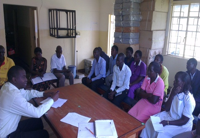Strengthening Human Resources for Health in Uganda

By John Byabagambi, University Research Co.
Working with frontline health workers to improve medicines use and management in HIV care
NOTE: This post originally appeared in the K4Health Blog. Humphrey Megere and Tana Wulji, both URC staff of USAID’s Applying Science to Strengthen and Improve Systems Project (ASSIST) contributed to this blog. This activity was made possible with the support of PEPFAR.
What’s the story?
Imagine a situation where health facilities are unable to accurately estimate medicine needs or submit timely requisitions and are not able to monitor the expiry of HIV medicines in storage, all contributing to medicine shortages. Almost half of the 12 health facilities we surveyed at baseline from Eastern Uganda in March 2012 experienced stock-outs of TB medicines and HIV testing kits for at least two of the six months.
We also found that of the medicines dispensed to clients, 23% were not labeled with any instructions on how to take them. If medicines were labeled, a third of the time, they could not be read by clients. In the end, only 57% of the clients receiving anti-retroviral therapy could correctly explain instructions on how to take their medicines immediately after leaving the dispensary. Imagine the impact these situations have on HIV patients! Not knowing how to take their medicines could lead to poor adherence, greater side effects, as well as affecting how well the medicines work and ultimately the client’s health status.
So, what did we do about that?
We supported 14 health facilities to form Quality Improvement teams which then went ahead to Identify gaps, develop and test changes in their daily routines at the facility, to improve medicines ordering, storage and dispensing.
“The coaches supported us to form a medicines management committee, before we formed the committee, the store man used to make the drug orders without consulting anyone and we would run short of drugs and even receive drugs which we didn’t use frequently t and miss some of the drugs we use frequently” – Health worker in Eastern Uganda
“One person was supposed to receive the prescription, get the medicines, pack and label, explain to the client how to take the medicine and record the clients in the dispensing and because of the many clients we never used to do most of these especially explain to the client how to take the medicines. We also had no time to update the dispensing log because all we wanted to do was to clear the line of patients” – Health worker in Eastern Uganda
The teams also set out to spend more time counseling clients on how to take their medicines, requesting that they repeat the instructions and clearly labeling pill envelopes. This was made possible through reviewing the flow of events to evenly distribute tasks among staff and thus create more time for the dispensers, who were previously overloaded with tasks. Prepacking of common medicines like Cotrimoxazole was done before the clinic opens for the day. This enabled the health workers to have more time for dispensing medicine. Also, HIV patients’ treatment supporters assisted their clients who could not read instructions.
We provided onsite mentorship to each team at the health facility every month, together with the district health office staff, to build their competencies to apply improvement approaches. After four months, we brought teams together in each district to share their experiences, challenges and results.
What about the results?
Evidence from the health facility records actually shows that the ART (antiretroviral therapy) adherence has greatly improved. One facility has improved from average adherence level of 56% in April 2012 to 90% in June 2013. Some factors that contributed to this improvement had to do with improved staff performance as a result of reducing their work overload, for example, the dispensing staff had been assigned a lot of tasks and therefore had little time to explain to the clients how to take their medicines. This was addressed through role re-distribution and improved communication with the clients, on how to take their medication. The percentage of clients with good clinical outcomes on ART has also improved from 60% to 80% in a period of one year.
Any lessons learnt?
The improvement we have seen in service provision at the health facilities can be greatly attributed to the staff involvement and interest in their own performance at the place of work, and not necessarily from an external supervisor. These internally driven changes lead to sustainable improvement because they are owned and not imposed on the health workers by external supervisors. Applying such approaches can be helpful in not just in improving health care, but also medicines availability and use. We shall continue to support the teams at the health facilities to keep on improving their work performance.

